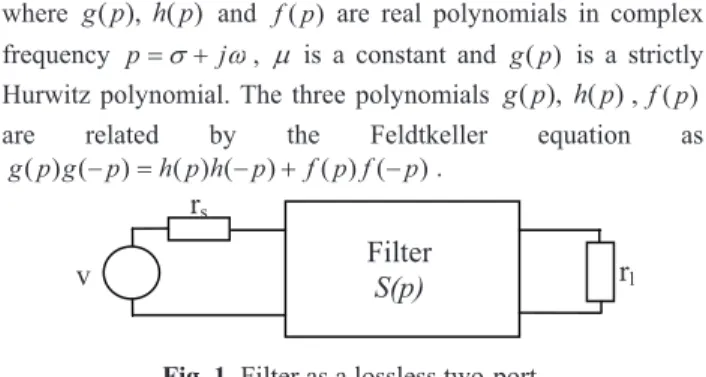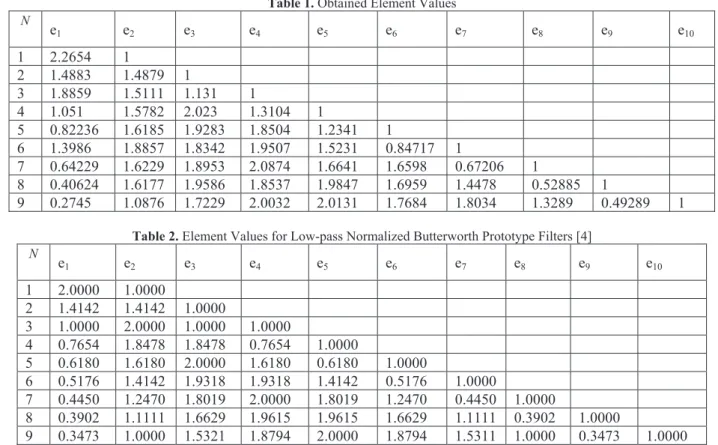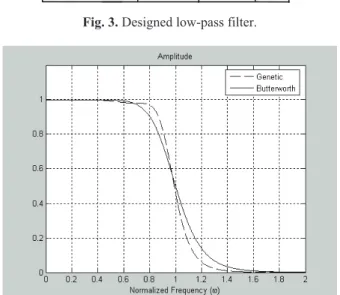Realization of Ideal Filter Characteristics via Genetic Algorithm
Metin Sengul
1, and Atilla Özmen
2 1,2Kadir Has University, Faculty of Engineering, Fatih-Istanbul, Turkey
msengul@khas.edu.tr, aozmen@khas.edu.tr
Abstract
In this paper, realization of ideal filter characteristics via genetic algorithm has been studied. The filter is defined as a lossless two-port terminated normalized source and load resistances, and the coefficients of its describing scattering polynomials have been calculated via genetic algorithm. An element value table has been given for a low-pass normalized prototype filter containing only one element to ten elements.
1. Introduction
A filter is a two-port network used to control the frequency response at a certain region in a system by providing transmission within the pass-band and attenuation in the stop-band. The ideal filter would have zero insertion loss in the pass-band, infinite attenuation in the stop-pass-band, and a linear phase response in the pass-band.
By using the image parameter method, filters can be designed, and they consist of a cascade of simpler two-port filter sections to provide the desired cutoff frequencies and attenuation characteristics, but do not allow the specification of a frequency response over the complete operating band. Thus although the procedure is relatively simple, the design of filters by the image parameter method often must be iterated many times to achieve the desired response.
A more modern procedure is the insertion loss method. It uses network synthesis techniques to design filters with a completely specified frequency response. The design is simplified by forming low-pass normalized filter prototypes. Then frequency and impedance transformations are applied to convert the prototype filters to the desired frequency range and impedance level.
In this paper, low-pass normalized prototype filter element values are obtained via a genetic algorithm based approach. In the optimization part, ideal low-pass filter characteristic has been utilized.
In the next section, description of a lossless two-port is summarized shortly, and then genetic algorithm is explained in a brief manner. Then after describing the proposed procedure, element value table for low-pass normalized prototype filter is given.
2. Scattering Description of Lossless Two-ports
For a lumped-element lossless two-port like the one depicted in Fig. 1, the scattering matrix can be written as [1]:
! " # $ % & ' ' ' ( ! " # $ % & ( ) ( ) ( ) ( ) ( ) ( 1 ) ( ) ( ) ( ) ( ) ( 22 21 12 11 p h p f p f p h p g p S p S p S p S p S ) ) (1)
where and are real polynomials in complex
frequency ) ( ), (p h p g f( p) * + j
p( , , ) is a constant and is a strictly Hurwitz polynomial. The three polynomials , are related by the Feldtkeller equation as
) ( p g ) ( ), (p h p g f( p) ) ( ) ( ) ( ) ( ) ( ) (pg p h ph p f p f p g ' ( ' , ' .
Fig. 1. Filter as a lossless two-port.
If the two-port is reciprocal, then the polynomial is either even or odd. In this case,
) ( p f 1 , ( ) if f( p) is even, and 1 ' (
) if is odd. As a result, for a lossless reciprocal two-port ) ( p f 1 ) ( ) ( -( ' ( p f p f ) (2a)
and the Feldtkeller equation can be modified as
2 ) ( ) ( ) ( ) ( ) (p g p h ph p f p g ' ( ' ,) . (2b)
3. Genetic Algorithm
Genetic algorithm is a heuristic search algorithm that inspired by the biological evolution process and used to find the solution of the optimization problems. Algorithm is started with a set of possible solutions. This set of solutions is called as population and represented by chromosomes.
One common application of genetic algorithm is function optimization, where the goal is to find a set of parameter values that maximize a multi-parameter function (fitness function).
3.1. Genetic Algorithm Operators
The basic form of genetic algorithm consists of three types of operators: selection, crossover and mutation [2]. Selection operator selects chromosomes in the population for reproduction. Crossover decomposes two distinct solutions and then randomly mixes their parts to form new solutions. Mutation randomly alters some of gene values in a chromosome from its initial state. This operation results in new gene values and better solutions values can be obtained from this new gene values.
A simple genetic algorithm works as follows [2,3]:
1- Start with a randomly picked population. (Produce candidate solutions to a problem.)
2- Calculate the fitness values of each chromosome in the population.
r
sFilter
S(p)
r
lv
ELECO 2011 7th International Conference on Electrical and Electronics Engineering, 1-4 December, Bursa, TURKEY
3- Create new solutions (offspring) by repeating the following steps:
. Using fitness probabilities select a pair of parent chromosomes from the current population.
. Cross over the pair at a randomly chosen point to form two offspring.
. Mutate the two offspring and place the obtained chromosomes in the new population.
. Replace the current population with the new population. . Repeat process by starting from fitness value calculation
step.
4. Design Procedure via Genetic Algorithm
The desired filter response is assumed to be the ideal low-pass filter characteristic shown in Fig. 2. Since it is low-low-pass type, the polynomial is chosen as , namely all the transmission zeros are put to infinity. To be able to obtain the normalized termination resistor , the lowest ordered coefficient of polynomial is set to zero. The other coefficients of polynomial are chosen as the optimization parameters. Then by using (2b), the polynomial is obtained. ) ( p f f(p)(1 1 ( l r ) ( p h ) ( p h ) ( p g
Fig. 2. Ideal low-pass normalized prototype filter
characteristic.
Error is defined as the difference between the ideal characteristic seen in Fig. 2 and the characteristic calculated at each step as follows [6],
2 ) ( 1 ) ( * * j g TPG ( . (3)
At the end of the optimization process, it is desired that of the designed filter will have the same form as seen in Fig. 2. So it is desired to realize the ideal characteristic. But after performing the genetic algorithm based design procedure, it is seen that it is not possible to realize the ideal characteristic, and the obtained characteristic converges to Butterworth characteristic naturally.
TPG
Then an element value table similar to the table exist in literature has been formed, (Table 1). By using the table, low-pass normalized prototype filter containing one element to ten elements can be designed easily without any calculation. In this table, represents the number of elements in the filter, the last element value is the normalized termination resistance (
N
1 (
l r ), and normalized source resistance is equal to rs(1.
From the low-pass normalized Butterworth prototype filter tables exist in literature (Table 2), it is seen that these filters are symmetric [4]. So to be able to design symmetric filters, we have restricted the coefficient of the polynomial , namely except the highest ordered coefficient, all the coefficients must be zero [5]. So the highest ordered coefficient is chosen as optimization parameter. At the end of the optimization process, it is seen that the obtained elements values are exactly the same as values given in Table 2.
) ( p
h
Amplitude
Table 1. Obtained Element Values
N
e
1e
2e
3e
4e
5e
6e
7e
8e
9e
101
2.2654
1
2
1.4883
1.4879
1
3
1.8859
1.5111
1.131
1
4
1.051
1.5782
2.023
1.3104
1
5
0.82236
1.6185
1.9283
1.8504
1.2341
1
6
1.3986
1.8857
1.8342
1.9507
1.5231
0.84717
1
7
0.64229
1.6229
1.8953
2.0874
1.6641
1.6598
0.67206
1
8
0.40624
1.6177
1.9586
1.8537
1.9847
1.6959
1.4478
0.52885
1
9
0.2745
1.0876
1.7229
2.0032
2.0131
1.7684
1.8034
1.3289
0.49289
1
able 2. Element Values for Low-pass Norma d Butterw Proto Filters
e
e
e
7e
8e
e
10T lize orth type [4]
N
e
1e
2e
3e
4 5 6 91
2.0000
1.0000
2
1.4142
1.4142
1.0000
3
1.0000
2.0000
1.0000
1.0000
4
0.7654
1.8478
1.8478
0.7654
1.0000
5
0.6180
1.6180
2.0000
1.6180
0.6180
1.0000
6
0.5176
1.4142
1.9318
1.9318
1.4142
0.5176
1.0000
7
0.4450
1.2470
1.8019
2.0000
1.8019
1.2470
0.4450
1.0000
8
0.3902
1.1111
1.6629
1.9615
1.9615
1.6629
1.1111
0.3902
1.0000
9
0.3473
1.0000
1.5321
1.8794
2.0000
1.8794
1.5311
1.0000
0.3473
1.0000
*1
1
ELECO 2011 7th International Conference on Electrical and Electronics Engineering, 1-4 December, Bursa, TURKEY
normalized element values of the filter are as 4 3 2 1 e e e e ( ( ( ( 5 4 3
Now let us design a low-pass filt ith cutoff frequency
GHz
1 and termination resistances 50/. From Table 1 and Table 2, er w follows: ), 1 ( 1 , 2341 . 1 , 8504 . 1 , 9283 . 1 , 6185 . 1 , 82236 . 0 5 r fromTable e ( l( 1 , 6180 . 0 , 6180 . 1 , 2 , 6180 . 1 , 6180 . 0 2 1 e ( e ( e ( rl( (fr fn(
elements are calculated by using the (
( e
e
om Table 2).
These normalized values must be deno using
frequency normalization number 1GHz , and
impedance normalization number as Rn( 50/. Then actual values of the filter
rmalized by as following formulae: n n i f 2 i R e C ( , 0 20 fn
where Ci, Li and Ri repres
n iR e L (
ent the capacitor, inductor and res , 9283 . 3 , 1380 . 6 , 6177 . 2 1 3 2 1( ( ( L pF C pF C pF C , 9672 . 1 , 3662 . 6 , 9672 . 1 1 3 2 1( ( ( L pF C pF C pF C
and its characteristic are given in Fig.
and 4, re ely.
Fig. 3. Designed low-pass filter.
i , R (i rRn,
istor values, respectively.
For Table 1, the real elements values are: . 50 , 725 . 14 , 88 . 12 2( ( / ( nH L nH RL
For Table II, the real element values are: . 50 , 876 . 12 , 876 . 12 2( ( / ( nH L nH RL
The designed filter
3 spectiv
Fig. 4. Chara
d the
filter given in literature.
5. Con usions
actly the same component values are obtained as the values obtained in literature via inserti alytically.
[2]
land, 1999.
[5]
[6]
and distributed elements for broadband matching, Ph.D. dissertation, Bochum, Ruhr University, 1994.
cteristics of the designed filter an
cl
So it is concluded that ideal filter characteristic is not possible to realize. In this paper, after trying to realize the
ideal characteristic, it is seen that the filter response naturally converges to Butterworth response. By using genetic algorithm, after restricting some coefficients, ex
on loss method an
6. References
[1] V. Belevitch, Classical Network Theory, San Franciscoi CA: Holden Day, 1968.
M. Mitchel, An Introduction to Genetic Algorithms, A
Bradford Book The MIT Press, Cambridge,
Massachusetts, London, Eng
[3]
S.R. Ladd, Genetic algorithms in C++, N.Y. M&T
Books, New York, 1996
[4] D. M. Pozar, Microwave Engineering, John Wiley & Sons, Inc., 3rd ed., 2005.
Çimen Gürsu E., Toplu ve Karı!ık Elemanlı Kayıpsız "ki Kapılı Devrelerin Parametrik Tasarımı, Ph.D. dissertation, Istanbul, Istanbul University, 2000. Aksen A, Design of lossless two-port with mixed lumped
V
C
1C
2C
3L
1L
2 50 / 50 / L RELECO 2011 7th International Conference on Electrical and Electronics Engineering, 1-4 December, Bursa, TURKEY


